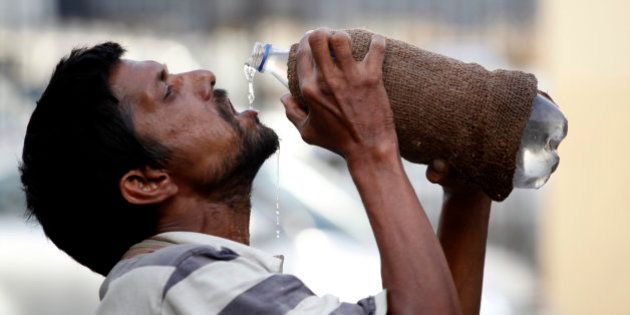
This May, a sudden outbreak of diarrhoea in Delhi left many of its denizens queuing up to the nearest doctor's chambers. While trips to toilets, doctors and pharmacies summed up another Delhi summer, the cause of such recurring phenomenon didn't get as much care and attention as the effect it produced. With "Delhi belly" spin doctored to symbolize a cultural right of passage for residents and tourists, a serious public health concern has been successfully trivialised. And the potent pairing of jokes and antibiotics has always seen Delhiites through.
A number of studies keep reinforcing the fact that people in Delhi do not have safe water to drink. In 2012, the Municipal Corporation of Delhi went around checking the quality of water in houses receiving supply from the Delhi Jal Board. Much to their surprise and everyone else's horror, 70% of the samples were tested positive for contamination. The Delhi Jal Board was of course quick to refute the findings, suggesting their own testing showed contamination of 1 to 2% of their total samples.
An interesting find of the contentious 2012 MCD report was that wealthier conclaves in Delhi were as vulnerable to water contamination as poorer ones. Water in Delhi therefore proved to be strangely egalitarian in its ability to loosen the sphincters and purse strings of the rich as much as the aam aadmi. However, even after surrounding themselves with all kinds of cheap and expensive water filters, Delhiites are unable to shed themselves of the dreaded summer runs.
After a rendezvous with the Delhi runs this summer, I decided to get all the supplied water in my apartment tested. In most cities in India, a hundred laboratories offer to test your blood at the convenience of your home. For water, however, there were hardly any takers. A few willing ones were a long distance and 44° Celsius away. This is where one discovers a strange pathology of our water market. One can choose from a 100 different types of water purifiers at the click of a button, but it is incredibly difficult to procure even one product to test the quality of the water being consumed.
"One can choose from a 100 different types of water purifiers at the click of a button, but it is incredibly difficult to procure even one product to test the quality of the water being consumed."
As I was about to give up hope, I discovered a tiny advertisement in a Sunday newspaper. A private company was offering laboratory water testing of samples collected from the doorstep. With rehydrated enthusiasm, I paid through my nose to test both the tap and filtered water. Remarkably, both sources showed the presence of Escherichia coli (i.e., E.coli), a strain of bacteria known to cause diarrhoea.
Such a scary discovery is part of growing evidence that question the claim that water, when well paid for, is always safe to drink. The 20-litre bottle supplied to me every week by a precocious 19-year-old guarantees safety through a company logo and a sealed cap. Well-known brands fetch higher prices. But that doesn't lessen the risk. Hence, unable to pay their way out of a governance failure, many Delhiites reverted to the age-old practice of boiling their water this year. A middle class habit they had aspired to leave behind.
However, E.coli is not the only contaminant in our drinking water supply that we need to be worried about. New kinds of public health challenges are emerging from various types of chemical contamination. Nitrate contamination of groundwater causes "blue baby syndrome", which reduces the carrying capacity of oxygen in haemoglobin in babies and can lead to their death. Severe arsenic contamination of groundwater in West Bengal, Bihar, Uttar Pradesh, Jharkhand and Assam have left 50 million people vulnerable to its health impacts. Excessive fluoride in groundwater has led to affecting more than a million people in India with fluorosis. While touring rural West Bengal, I had come across school children drinking water from arsenic removal filters where the filtration media had remained unchanged for years. Be it blind faith of the poor in public water filters in rural Bengal, or expensive water purifiers in urban Delhi, common citizens in India are helplessly unaware of their drinking water quality.
"The helplessness is multiplied by the fact that even if you knew your water was unsafe, there is very little you can do about it."
Huge investments are made on advertisements, to carefully cultivate panic, which translates into whopping water purifier sales. Unfortunately, that's where the buck stops. The next step was to generate greater consumer awareness on water quality testing. Globally, this opportunity has sunk without a trace. In India, people are caught between weak regulation and low awareness. The helplessness is multiplied by the fact that even if you knew your water was unsafe, there is very little you can do about it.
But things are changing. There is growing demand for water quality testing in urban areas, which large laboratories are readying to tap. Internationally, a number of ideas are getting invested in, which would make home based water testing as easy as checking body temperature or blood pressure. Hopefully, as consumers produce more water quality data, it will create pressure for improved products and better monitoring of supply chains. What is sadly lacking is a publicly accessible web platform where people can start uploading their water quality testing results. That would give water utilities rich data on status and patterns of water contamination. Sadly, the poor, who are most affected, will remain invisible in such schemes unless such services and innovation is made more inclusive.
Needless to say, testing for quality will not improve weak water governance. But it will bring in much needed evidence to the table. Currently water suppliers are testing the water they provide or purify, and claiming it to be safe. Independent citizen monitoring can help call bluff.
It's an opportunity worth betting on.



Contact HuffPost India